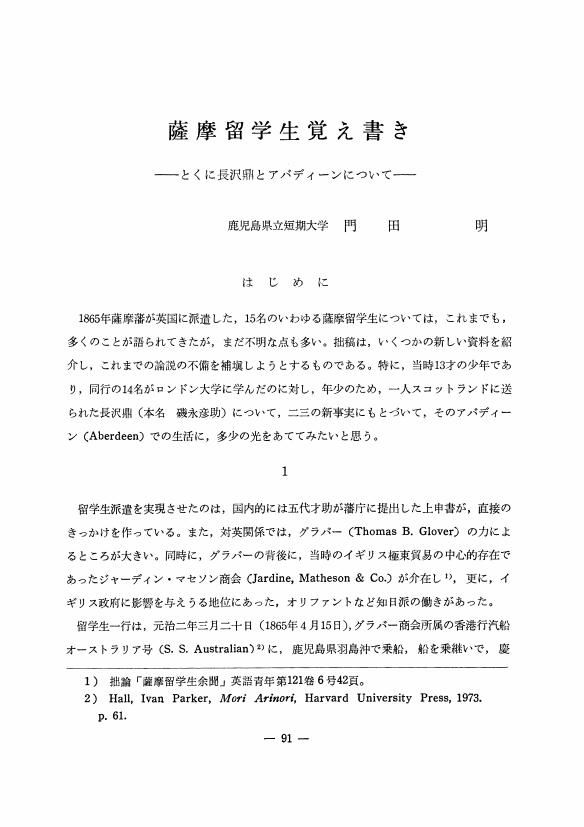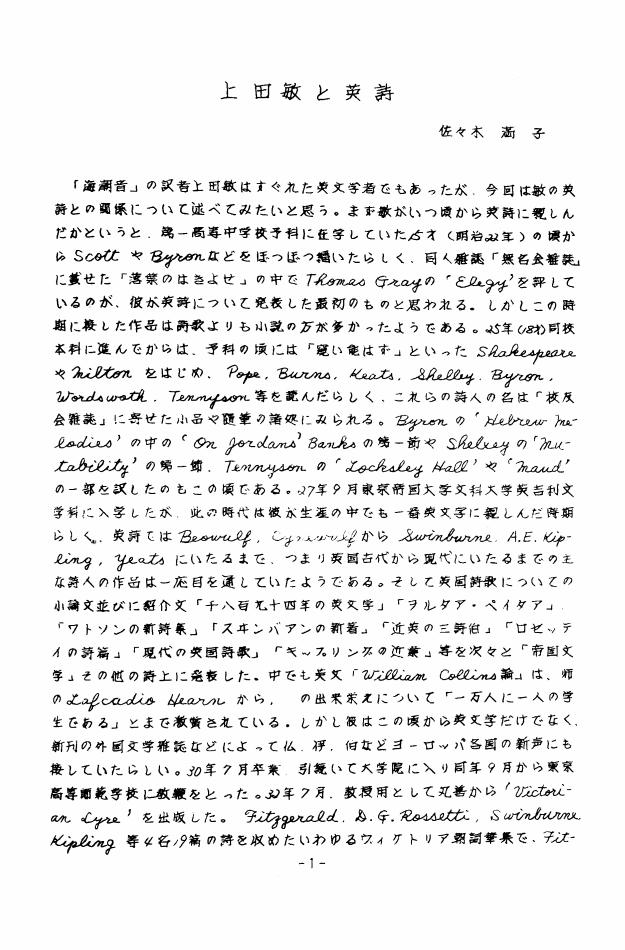1 0 0 0 OA 日本におけるロバート・バーンズのFora, That, anda, Thatの紹介
- 著者
- 本多 仁禮士
- 出版者
- 日本英学史学会
- 雑誌
- 英学史研究 (ISSN:03869490)
- 巻号頁・発行日
- vol.2005, no.37, pp.33-45, 2004 (Released:2010-05-07)
- 参考文献数
- 15
Robert Burns is one of the most famous English poets since the Meiji era in Japan. The elementary school song “Light of Firefly” was written as a parody of Burns' “Auld Lung Syne”. Therefore, many Japanese have had an attachment to him. Since the Meiji era, many books have been written and published about this poet's works and his life.I studied who introduced Robert Burns and his works for the first time into Japan, and who familiarized his “For a' That, and a' That” to the then Japanese in which his true humanity was portrayed. Toshio Nanba, the leading Robert Burns scholar in Japan, contributed eight bibliographies on Robert Burns since 1958 to The Bulletin of Japan Comparative Literature Association. And eventually, he published the Bibliography of Robert Burns in Japan as a corpus of bibliographical work on Burns in 1977. Furthermore, in 1982 he wrote the article titled Burns in the Meiji Era Influence. He described that the first introduction of Robert Burns was made in Kanichi Hashizume's Saigoku Risshihen Retsuden Nanba also pointed out that one of the earliest introductions of “For a' That, and a' That” into Japan was in The New Magazine Devoted to the Study of Language and Literature issued in August, 1892.In this article here, I would like to bring to your attention, that the first introduction of Robert Burns was made in the Saigoku Risshihen translated by Masanao Nakamura in 1871. In this book, he introduced Robert Burns as the poet. Of course, Toshio Nanba had known this fact. Nevertheless, he claimed that the first introduction of Robert Burns was made in Kanichi Hashizume's Saigoku Risshihen Retsuden I also point out that another initial introduction of “For a' That, and a' That” was in the Transcription of Lecture on English Literature issued issued in April, 1892. Finally, I would like to point out a possibility. That is, some Japanese had heard “For a' That, and a' That” which was read at a party 'A NIGHT WI' BURNS' in Yokohama Settlement in 1864. It wasn't an event for the Japanese at that time, but a Japanese was presented as a juggler.
1 0 0 0 OA 薩摩留学生覚え書き
- 著者
- 門田 明
- 出版者
- 日本英学史学会
- 雑誌
- 英学史研究 (ISSN:03869490)
- 巻号頁・発行日
- vol.1978, no.10, pp.91-100, 1977-09-01 (Released:2009-09-16)
- 参考文献数
- 8
1 0 0 0 OA 上田敏と英詩
- 著者
- 佐々木 満子
- 出版者
- 日本英学史学会
- 雑誌
- 日本英学史研究会研究報告 (ISSN:18839274)
- 巻号頁・発行日
- vol.1966, no.51, pp.b1-b7, 1966-06-11 (Released:2010-11-17)
1 0 0 0 OA 太平洋郵船と英学史
- 著者
- 西岡 淑雄
- 出版者
- 日本英学史学会
- 雑誌
- 英学史研究 (ISSN:03869490)
- 巻号頁・発行日
- vol.1993, no.25, pp.87-101, 1992 (Released:2009-10-07)
- 参考文献数
- 20
Steamship lines between San Francisco and Yokohama were opened in 1867 by the Pacific Mail Steamship Company, the Colorado being the first steamer that arrived in Yokohama.The steamers on this line were the Colorado, the Great Republic, the America, the Japan, and the China. They were wooden paddle steamers, among which the America was destroyed by the fire on Aug. 24, 1872 at Yokohama.Later, the City of Tokio and the City of Peking, iron ships with propellers, were added to the line up.A large number of passengers Japanese as well as foreign crossed the Pacific. Those who went over to America and Europe using this line for the purpose of studying abroad contributed to the civilization of a new Japan.We can find the list of passengers in the columns of English newspapers But their names are often misspelt by the editors of the paper. So it is sometimes puzzling who the names refer to.
1 0 0 0 OA 高嶺秀夫と開発教授法
- 著者
- 多田 洋子
- 出版者
- 日本英学史学会
- 雑誌
- 英学史研究 (ISSN:03869490)
- 巻号頁・発行日
- vol.2005, no.37, pp.21-31, 2004 (Released:2009-09-16)
- 参考文献数
- 23
One of the teaching methods introduced in the Meiji era was the “Kaihatsu Kyoju Ho” methodology for developing the five senses. Hideo Takamine, as Head of Tokyo Teacher's School (Tokyo Shihan Gakko), contributed a lot to the introduction and promotion of the method. By examining the essay about class activity and the teacher's manual, this paper discusses how Hideo Takamine applied “Kaihatsu Kyoju Ho” to English teaching methodology.The characteristics of “Kaihatsu Kyoju Ho” can be seen in the following three principles.(1) Teaching inductively(2) Teaching from the known to the unknown(3) Using objectsTakamine stressed the importance of using objects in his class of English Teaching at Tokyo Teacher's School. The teacher's manual (kyoju saimoku) was compiled based on the three principles stated above. However, Takamine's methodology was not simply an application of “Kaihatsu Kyoju Ho.” It also consisted of procedures and content that was uniquely intended for Japanese learners. For example, lists of words and phrases which were difficult for Japanese learners to pronounce were included. He suggested that different skills such as reading and writing be taught with integration. Takamine's methodology was unique in the sense that he applied “Kaihatsu Kyoju Ho” to English Teaching and that it was intended for Japanese learners of English.
- 著者
- 平田 諭治
- 出版者
- 日本英学史学会
- 雑誌
- 英学史研究 (ISSN:03869490)
- 巻号頁・発行日
- no.42, pp.65-86, 2009

